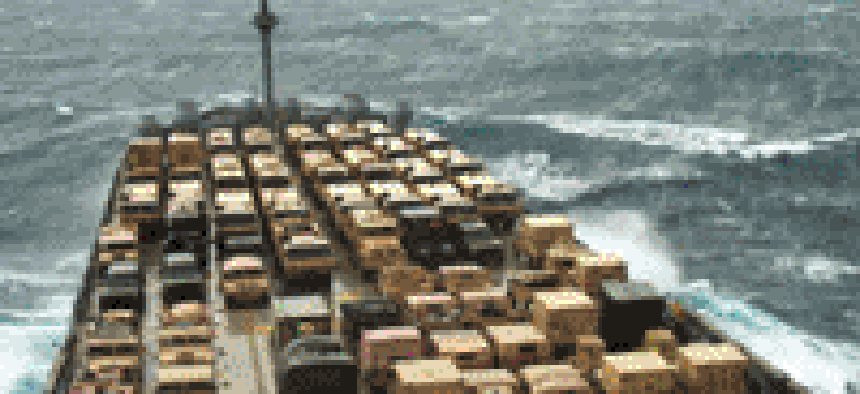From databases to UAVs, IT goes to war

<FONT SIZE=2>During the past several weeks, the Army has been preparing for war by installing hundreds of its tactical vehicles in Kuwait with a tracking system that uses satellites to transmit e-mail between troops and commanders and to show vehicle operators their precise positions.</FONT>

The MV Cape Texas heads for the Arabian Gulf ,carrying trucks for the 4th Infantry Division (Mechanized) of Fort Hood, Texas. Trucks such as these are being equipped with a system that can transmit e-mail between troops and commanders.
U.S. Transportation Command
Although the eight-year, $418 million Movement Tracking System contract was awarded in June 1999, the Army only recently began installing the systems on tactical vehicles, such as Humvees. Using commercial and Defense Department Global Positioning System satellites, the tracking system makes it possible to identify positions and monitor the progress of vehicles.
Comtech Mobile Datacom Corp. of Germantown, Md., built 5,600 of the systems for the Army. It takes less than an hour to install the equipment in most vehicles; larger vehicles take a little longer, officials said.
"MTS will help get logistics faster to where it needs to be to support the soldiers," said Robert Straub, deputy assistant project manager for the system.
The accelerated installation of the tracking system on Army vehicles is one of many ways the military is putting to use new information technologies -- from tracking troops and supplies to planning attacks and carrying them out -- to bolster the fighting power and overall effectiveness of armed forces in Iraq.
Military officials have dispatched unmanned aerial vehicles, or UAVs, to cover the country and provide support to the troops. The Navy set up mobile hospitals with built-in systems infrastructures that integrate communications with Joint Forces commanders and tie back to the Composite Health Care System II database at the Navy Medical Center in Bethesda, Md.
The Navy also has outfitted mobile fleet hospital units with IT networks designed by GTSI Corp. of Chantilly, Va. The networks use Hewlett-Packard Co. servers; an IP-based PBX phone system from Shoreline Communications Inc. of Sunnyvale, Calif.; ruggedized Panasonic wireless notebook PCs; and medical software that gives hospital staff access to a patient's electronic medical records, officials said.
"This saves time and saves lives," said John Cantrell, an account executive with GTSI's Navy team. "It's faster response."
GTSI integrated more than 28 products to create a "deployable office" that replicates the offices medical personnel have back in the United States, said Dendy Young, GTSI's chairman and chief executive officer. "They even can use the same phone number," he said.
To monitor supplies -- "everything from butter to bullets" -- and speed up the logistics process, the Army is using a Web-enabled tracking system, Army spokesman Stephen Larsen said.
Military planners will rely on the Defense Meteorological Satellite Program for weather predictions in the theater.
"For the Army, obviously they want to know moisture and soil content. They don't want their tanks bogged down," said Maj. Gen. Judd Blaisdell, director of Space Operations and Integration for the Air Force. "The Navy needs to know winds and sea state. Obviously, the Air Force, we're not going to do refueling operations in thunderstorms."
Blaisdell added: "You need good reconnaissance. You need a good picture of the target if you're going to go in with your bomber sorties and be able to hit the target."
At the Combined Air Operations Center in southwest Asia, joint teams overseen by the U.S. Central Command direct missiles at targets, coordinate joint battlefield operations, plan search and rescue missions and offer special operations support to warfighters. This place is the nerve center for any air operations that occur during the strike on Iraq.
That includes UAV efforts. Dyke Weatherington, deputy director of the Defense UAV Planning Task Force for acquisition, technology and logistics, said eight UAV models -- such as the Air Force's Predator, the Marine Corps' Dragon Eye Backpack and the Army's Shadow 200 -- stand ready to perform intelligence, surveillance and reconnaissance missions in Iraq.
The UAV task force has outlined the direction in which the Defense Department wants to take the use of the vehicles over the next 25 years, Weatherington said. Among the areas of focus are adding weaponry that can be fired by controllers and using UAVs to better integrate other air assets.
The Military Traffic and Management Command has benefited from faster response since it began using the Multi-Media Communications System, a command, control, communications and computers suite that is installed in both the Mobile Port Operation Centers and the Deployable Port Operations Centers, to better track military cargo.
During the first Gulf War 12 years ago, the command tracked cargo using paper. The military moved more than 400,000 containers to the theater in 1991.
The traffic command, which has been deployed to port centers near Iraq, now provides immediate information on the location and status of a container and its contents, said Corrina Panduri, project leader with the Product Manager, Defense Wide Transmission Systems. *
Government Computer News staff writer Dawn Onley can be reached at donley@
postnewsweektech.com.